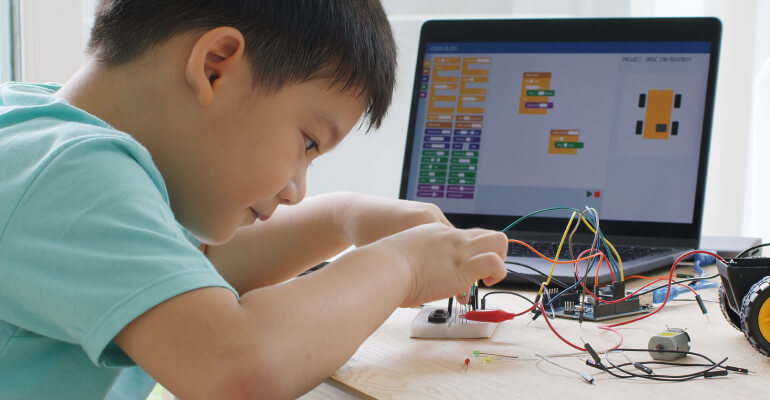Looking at the expansive growth of STEM education in the last ten years, you might be surprised to learn that so many antiquated myths around STEM education still prevail.
However, despite a 79% increase in STEM employment since 1990, the job force is still struggling to fill the many vacancies in the fields of STEM, and a portion of the gap can be attributed to these common STEM education myths. So, we’re taking these common misconceptions and bringing you the latest facts and figures in STEM education to prove their inaccuracies and bring STEM to more students!
Whether you’re a teacher, a parent, or a student, read on to be empowered by knowledge and learn more about these busted STEM education myths.

Myth #1: STEM education doesn’t start until middle school or high school.
It is never too early to start teaching STEM. In fact, the young creative minds of early learners are specially equipped to employ creative thinking and problem-solving skills as they explore their rather-new world.
A recent study by Purdue highlighted the significance of early exposure to STEM education. According to their research, when students were exposed to STEM education between the ages of 5 and 8, they were more likely to work in a STEM-related field as an adult.
Early access to STEM education helps build students’ confidence and fluency in STEM subjects, paving the way for future success in their educational and professional careers.
At Kid Spark, we are passionate about giving every child early access to STEM resources, with our classroom STEM programs starting at the Pre-K level.

Myth #2: STEM only exercises left-sided thinking.
Science, technology, engineering, and mathematics… where’s the creativity? The answer: everywhere.
Many of us have historically been led to believe that STEM subjects are solely logic-based fields where creative thinkers struggle, but the opposite is true. Creativity is woven into every STEM subject, from the earliest encounters with creative problem-solving in the classroom to the most complex STEM problems scientists, engineers, and mathematicians solve today.
Not only does creativity fuel STEM success, but STEM education also builds creativity! In a study published in 2021, STEM learning models actually improved students’ creative thinking skills, proving that both analytical and creative minds are significant contributors to the fields of STEM.

Myth #3: Only teachers with STEM degrees can teach STEM.
One of the most impactful roles in the STEM ecosystem is the STEM mentor—a role that does not require any specific degree.
Teachers and educators can be positive STEM mentors for their students, as well as parents, siblings, or grandparents—even without any STEM-specific education themselves.
[Read more about how to be a STEM mentor here.]
While no STEM degree is required to teach STEM subjects in elementary education, confident educators can pass on their confidence to their students. So, to help teachers feel more confident in their own STEM knowledge before teaching, Kid Spark provides comprehensive educator tools and professional learning resources to empower teachers in the classroom.
Myth #4: It takes a lot of resources and supplies to teach STEM in the classroom.
One of the great things about STEM education is its applicability to the real world, which requires little to no additional resources to teach in the classroom. There are many ways to bring hands-on STEM learning activities and lesson plans to the class from informal do-it-yourself lesson plans to comprehensive STEM programs like Kid Spark’s Lab Kits which provide everything you need from start to finish:
- Professional Development Resources
- NGSS-Aligned Curriculum
- Reusable Engineering and Robotic Components
- Multiple Lesson Plans and Design Challenges
- Teacher Lesson Plan Guides
- Student Workbooks
- Grading Rubrics & Unit Assessments
- And more…
We believe every child should have early access to STEM education. Though structured science-based curriculum is helpful in establishing the foundational fluencies in STEM, even reading STEM-oriented books to the class (here are some of our favorites), or using everyday objects for creative STEM challenges contributes to your students’ core understanding of STEM subjects.
And, if you’re interested in teaming up with Kid Spark to bring STEM education to your school, you can check out our STEM Equity Grants Program, here.

Myth #5: Engineering is too complicated for elementary students.
Elementary students are very capable of understanding and solving engineering problems when they are exposed to STEM concepts sequentially and consistently.
For example, our elementary program for grades 2nd-5th includes many hands-on lesson plans and learning activities to explore different types of structures and motion.
Read this blog to learn more about engineering basics for elementary students.

Myth #6: Boys are better at STEM subjects than girls.
This STEM education myth might sound outdated to you, but numerous recent studies have shown the continued disparity between boys and girls in confidence, educational pursuits, and careers in STEM.
The AAUW reports that women currently make up only 28% of the STEM workforce, while Ypulse’s teen survey notes a disparity in confidence much earlier, with 3x as many teen and tween boys believing they would be successful in an engineering career as girls.
Early exposure to STEM education and its mentors can boost girls’ confidence in STEM and help close the gender gap that still exists today.
Learn more about how STEM kits can boost confidence in girls.
Myth #7: The classroom is the only place to teach STEM education.
STEM is everywhere! That’s what makes science, technology, engineering, and mathematics so great for teaching in and outside the classroom.
Young learners exposed to an ecosystem of STEM information can experience the many wonderful ways STEM subjects coincide with the real world. In addition to the classroom, libraries, museums, after-school programs, science fairs, and other community events help foster a curiosity, and even passion, for STEM at a young age.
Keep kids exposed to many different implementations of STEM education from a young age, and don’t forget about all the fun STEM activities you can do right at home!

Myth #8: Students spend plenty of time on computers at home; they don’t need to be on computers at school.
It’s true, more students than ever before now have internet and computer access thanks to measures and initiatives put in place all over the country. While 95% of K-12 students have access to a computer and internet, over 2 million students still do not.
Aside from access, students still benefit from structured computer and computer science courses at school. The field of computer science continues to expand and create more opportunities for today’s students, so designated educational computer time is an important element of STEM education.
Myth #9: STEM education isn’t designed for all students.
Equitable access to STEM education is the cornerstone of our nonprofit organization, and that goes beyond bringing STEM kits to a diaspora of communities and schools across the country.
We recognize that every student learns differently, and we strive to create STEM programs and lesson plans that serve the diverse needs of all students. Our modular units and design challenges allow students to learn and experiment at their own pace, while our numerous integrations and activities within each lesson plan helps cater to the spectrum of learning styles in the classroom.
There are also additional ways teachers can serve their student’s diverse needs, such as these suggestions of how to support visual learners through STEM lesson plans in the classroom.
Myth #10: STEM education programs are unaffordable.
If financial restrictions are holding you back from bringing STEM education to your school, there are still opportunities to provide equitable access to STEM for your students.
A comprehensive STEM program that encompasses multiple grade levels and provides resources and curriculum tools for years to come can be an investment, but there may be ways to make these powerful programs more accessible.
At Kid Spark, we’re on a mission to provide equitable access to STEM education. That’s why we created the STEM Equity Grants Program. For schools serving a large amount of underrepresented students, the grant provides complete lab kits, professional learning tools, and curriculum.
You might also consider looking for outside funding to help support your goal in bringing a STEM education program to your classroom.
If the curriculum budget is tight, school administrators might also consider building a STEM enrichment program.
Bring Kid Spark Education to Your School
Are you ready to bring a science-backed, NGSS-aligned STEM education program to your school? Connect with a Kid Spark specialist today to design a STEM program that meets your needs.
.png?width=1270&height=453&name=Copy%20of%20Kid%20Spark%20Logo%20(Horizontal%20-%20Full%20Color).png)